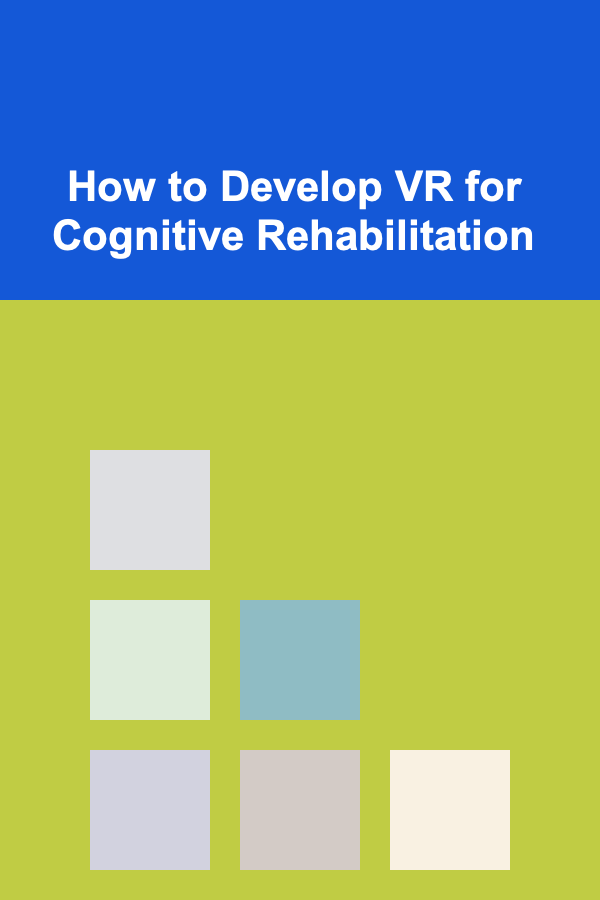
How to Develop VR for Cognitive Rehabilitation
ebook include PDF & Audio bundle (Micro Guide)
$12.99$7.99
Limited Time Offer! Order within the next:

Virtual Reality (VR) has emerged as a groundbreaking technology with significant potential to aid in the rehabilitation of various cognitive functions. By immersing individuals in a simulated environment, VR can be tailored to provide exercises that challenge and stimulate cognitive abilities, offering patients a chance to rehabilitate in a controlled and engaging way. This article will explore the process of developing VR systems for cognitive rehabilitation, covering the theoretical foundations, technological considerations, design principles, and practical implementation.
Introduction to Cognitive Rehabilitation
Cognitive rehabilitation refers to a range of therapies aimed at improving cognitive functioning in individuals affected by brain injury, neurological conditions, or psychiatric disorders. Cognitive functions such as memory, attention, executive function, language, and problem-solving can be impaired due to traumatic brain injury (TBI), stroke, dementia, or various cognitive disorders. Traditional rehabilitation methods often involve one-on-one therapy, exercises, and standardized cognitive tasks.
However, these traditional approaches may have limitations in terms of patient engagement, accessibility, and scalability. Virtual Reality offers a new paradigm for cognitive rehabilitation by creating immersive and interactive environments that can be customized to meet individual patient needs.
The Role of VR in Cognitive Rehabilitation
Virtual Reality (VR) provides an immersive, interactive experience that can engage patients in a safe, controlled, and repetitive manner, which is essential for cognitive recovery. By simulating real-world scenarios or generating abstract, complex environments, VR can target specific cognitive functions, such as:
- Memory: VR scenarios can be designed to challenge patients' memory recall by presenting various objects, tasks, or environments that require attention and retention.
- Attention: VR can immerse patients in complex, multi-tasking environments that challenge their ability to focus and switch attention between tasks.
- Executive Functioning: Through VR simulations, patients can practice decision-making, planning, problem-solving, and goal-setting in complex and realistic contexts.
- Spatial Navigation: VR environments that require navigation help individuals practice and improve spatial awareness and cognitive mapping.
- Motor Function and Perception: In addition to cognitive rehabilitation, VR can be used to enhance motor control, hand-eye coordination, and sensory perception.
The primary advantage of VR in cognitive rehabilitation is its ability to provide personalized, adaptive exercises within a highly engaging environment. This encourages active participation and can be particularly useful for patients who struggle with traditional cognitive rehabilitation methods.
Theoretical Foundations of VR-Based Cognitive Rehabilitation
To develop VR systems for cognitive rehabilitation, it is essential to understand the underlying psychological and cognitive principles that guide rehabilitation efforts. These include:
3.1. Neuroplasticity
Neuroplasticity is the brain's ability to reorganize itself by forming new neural connections in response to learning and experience. VR-based rehabilitation harnesses this capacity for change, providing repetitive and structured exercises that stimulate neural pathways involved in cognitive tasks. By challenging the brain in a controlled, motivating, and engaging way, VR promotes the rewiring of neurons and improves cognitive function over time.
3.2. Cognitive Load Theory
Cognitive Load Theory (CLT) posits that working memory has limited capacity and that overloading it with too much information can reduce learning efficiency. When designing VR rehabilitation tasks, it is important to consider cognitive load. Tasks should be challenging enough to engage the brain without overwhelming it. By gradually increasing the difficulty of tasks, VR rehabilitation systems can help patients progress at their own pace while minimizing frustration.
3.3. Embodiment and Presence
The concept of "presence" refers to the feeling of being fully immersed in a virtual environment. In VR, presence can be achieved through interactive, realistic simulations that allow patients to engage actively with the virtual world. Embodiment---the sense of owning a virtual body in the VR environment---can enhance the sense of agency and control, making the experience feel more real and meaningful. Both presence and embodiment are critical for VR-based cognitive rehabilitation, as they contribute to a more engaging, motivating, and effective experience.
Key Considerations for Developing VR for Cognitive Rehabilitation
4.1. Customization for Individual Needs
One of the most significant advantages of VR in cognitive rehabilitation is its ability to be highly customizable. Every patient's cognitive abilities, goals, and preferences vary, meaning that rehabilitation programs must be tailored to meet these unique needs. Customization should include:
- Difficulty Levels: The system must be capable of adjusting the difficulty of tasks in real-time, ensuring that patients are neither overwhelmed nor under-challenged.
- Task Selection: Different cognitive deficits require different rehabilitation strategies. VR programs must offer a variety of exercises to target specific cognitive functions like memory, attention, and executive function.
- Progress Tracking: A robust system for tracking patient progress is essential. This includes monitoring performance, identifying areas of improvement, and adjusting difficulty accordingly.
4.2. User Interface and Experience
The user interface (UI) and user experience (UX) are vital for ensuring that patients can effectively interact with the VR system. The design must be intuitive, especially for individuals who may have cognitive impairments or limited technological familiarity. Some key considerations include:
- Simple Navigation: Ensure that the VR system is easy to navigate, with clear visual cues and user-friendly controls.
- Feedback Mechanisms: Immediate and positive feedback can help reinforce learning and maintain engagement. Positive reinforcement in the form of rewards, points, or verbal encouragement can be motivating.
- Adjustable Settings: Patients with various cognitive and physical impairments may need adjustments in visual clarity, sound volume, or the complexity of tasks to optimize their experience.
4.3. Engagement and Motivation
Cognitive rehabilitation can be a long, tedious process, and keeping patients engaged is crucial for success. VR can boost motivation by offering a highly interactive and enjoyable experience. Game-like elements, rewards, achievements, and narrative-driven experiences can motivate patients to participate consistently. Gamification has been shown to improve adherence and make rehabilitation feel less like a chore and more like a fun activity.
4.4. Realism vs. Abstraction
When designing VR rehabilitation environments, the level of realism should align with the specific cognitive goals of the exercise. Some exercises benefit from highly realistic simulations (e.g., navigating a virtual city), while others may be better suited to abstract environments that focus purely on cognitive tasks without the distraction of real-world details.
- Realistic Environments: For tasks like spatial navigation or memory exercises involving real-world scenarios (e.g., shopping in a store, cooking in a kitchen), realistic VR environments are essential.
- Abstract Environments: Tasks that require concentration, attention, and problem-solving may benefit from abstract, distraction-free environments, where the focus is entirely on the cognitive exercise.
4.5. Safety and Accessibility
Ensuring that VR rehabilitation systems are safe and accessible for all patients is critical. Safety protocols should be built into the system to prevent accidents or injuries during use. For example:
- Movement Restrictions: Some patients may have limited mobility, so VR systems must accommodate physical limitations. It may involve seated VR exercises or options for users to control the system with minimal movement.
- Comfort Features: VR can be disorienting or physically uncomfortable, especially for patients with sensory processing issues. Customizable comfort settings (e.g., adjusting the field of view or minimizing motion sickness) should be included.
- Voice Commands: For individuals with motor impairments, voice commands or eye-tracking technology may be incorporated to control VR experiences.
Developing VR Exercises for Cognitive Rehabilitation
The design of VR exercises for cognitive rehabilitation requires careful thought to ensure they effectively target the desired cognitive functions while maintaining patient engagement. The exercises should be evidence-based and informed by clinical research on cognitive rehabilitation. Here are some examples of VR exercises that could be developed:
5.1. Memory Exercises
Memory exercises in VR could involve scenarios where patients must recall specific information or objects presented earlier in the experience. For example, the patient might navigate through a virtual room and be asked to remember the locations of various items. The system could increase the difficulty by adding distractions or requiring the patient to remember more items.
5.2. Attention and Focus Tasks
Attention exercises could involve tasks where patients are asked to focus on a particular object or activity while ignoring distractions. VR can simulate high-traffic environments like busy streets or crowded rooms, allowing patients to practice filtering out irrelevant stimuli and maintaining concentration.
5.3. Executive Functioning Tasks
Executive functioning tasks might involve problem-solving scenarios, such as managing virtual daily tasks like meal planning, budgeting, or organizing a schedule. These exercises can help patients practice planning, decision-making, and goal-setting in a safe and controlled environment.
5.4. Social Interaction Simulations
For patients who have difficulty with social interactions, VR can provide a safe space to practice social skills. Simulations could involve interacting with virtual characters in scenarios like job interviews or casual conversations, helping patients build confidence and improve their social functioning.
Conclusion
Developing VR for cognitive rehabilitation holds immense promise for improving patient outcomes in cognitive recovery. By combining the principles of neuroplasticity, engaging design, and cutting-edge technology, VR can create personalized, immersive rehabilitation experiences that enhance patient engagement, motivation, and cognitive recovery.
To create effective VR systems for cognitive rehabilitation, developers must carefully consider factors such as individual patient needs, ease of use, and task customization. Through careful design, VR can be a powerful tool for improving memory, attention, executive function, and other cognitive abilities, helping patients reclaim their independence and improve their quality of life.
While there are still challenges to overcome, including accessibility, safety, and scalability, the potential of VR in cognitive rehabilitation is vast. With continued research and innovation, VR can become an indispensable tool in the future of cognitive health care.

How to Decorate with Less by Embracing Minimalism
Read More
How to Design a Party Menu That Will Wow Your Guests
Read More
How to Maintain Work-Life Balance with Effective Time Management
Read More
How to Maximize Space in a Small Laundry Room
Read More
How to Handle Technical Difficulties During a Speech
Read More
How to Find Reliable Wi-Fi for Remote Work Anywhere
Read MoreOther Products

How to Decorate with Less by Embracing Minimalism
Read More
How to Design a Party Menu That Will Wow Your Guests
Read More
How to Maintain Work-Life Balance with Effective Time Management
Read More
How to Maximize Space in a Small Laundry Room
Read More
How to Handle Technical Difficulties During a Speech
Read More